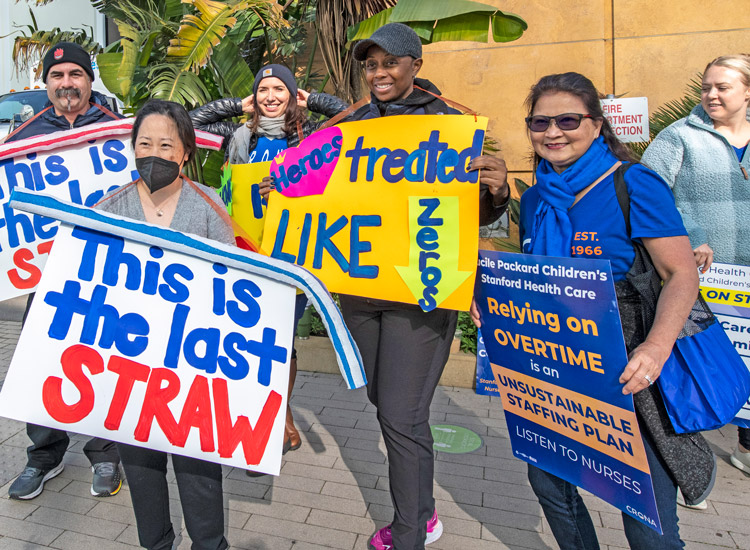EMERYVILLE, Calif. — Five days after 5,000 nurses, members of the Committee for Recognition of Nursing Achievement, struck the Stanford Health Care system — based at Stanford University in Palo Alto — they voted by an 83% majority to approve a new contract offer. The strike began April 25 and Stanford brought in 2,500 “traveling nurses” to replace strikers at Stanford Hospital, Lucile Packard Children’s Hospital and Stanford Health Care centers in the area, promising them up to $13,000 a week to cross the picket lines.
The nurses won a 7% raise this year, and 5% each of the next two years, as well as improved retirement benefits. They went back to work May 3.
Burnout caused by job stress, overtime and understaffing were key concerns of the nurses, whose confidence and good humor marked their spirited picket lines across the Bay Area. The new contract adds a week of vacation, improves access to mental health care, student loan assistance and a company promise to make sure patients are covered during nurses’ breaks and lunches. The contract also improves retirees’ health care benefits.
Nurses working in areas with the most severely ill patients will receive incentive pay and improvements in working conditions.
“Amid a nationwide shortage of nurses driven by high levels of burnout, moral injury, exhaustion and trauma, hospitals need to step up their support for the nursing profession,” Kathy Stormberg, Committee for Recognition of Nursing Achievement’s vice president, told reporters. A 2021 report showed hospitals in California are short some 40,000 full-time nurses. “Creating better and safer working conditions for nurses is directly connected to ensuring the best care conditions for the patients who are in our charge.”
In an attempt to force the nurses back to work, the “nonprofit” company had threatened to cut off their health benefits.
The nursing achievement committee was founded in 1966 at a time when it was illegal in California for nurses at a “nonprofit” to unionize. They’ve since won the right to do so.
Due to federal pandemic funding and “strong patient volume,” revenue at the Stanford Health Care complex grew 16%, to a combined $8.3 billion, according to their financial disclosure for the 2021 fiscal year. In other words, a gift from the U.S. government and the horrors of the COVID-19 pandemic boosted the “nonprofit” system’s profits, while nurses and other hospital staff paid the price.
As nurses returned to work, Stanford’s physicians and interns voted by 81% to unionize in the Committee of Interns and Residents.


